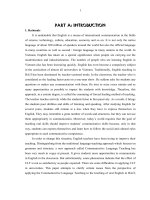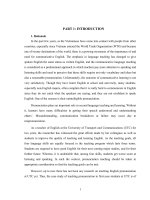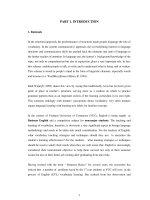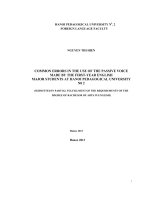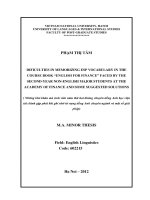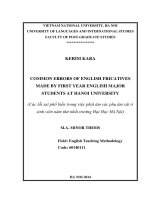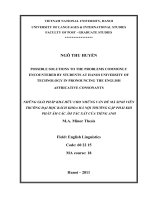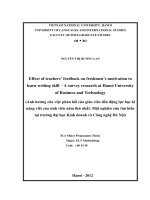Problems experienced by teachers in teaching writing to English major students at Hanoi University of Industry and suggested solutions
Bạn đang xem bản rút gọn của tài liệu. Xem và tải ngay bản đầy đủ của tài liệu tại đây (454.54 KB, 57 trang )
i
VIETNAM NATIONAL UNIVERSITY, HANOI
UNIVERSITY OF LANGUAGES AND INTERNATIONAL STUDIES
FACULTY OF POST – GRADUATE STUDIES
-------------------
BÙI HỒNG VÂN
PROBLEMS EXPERIENCED BY TEACHERS IN TEACHING
WRITING TO ENGLISH MAJOR STUDENTS AT HANOI
UNIVERSITY OF INDUSTRY AND SUGGESTED SOLUTIONS
(CÁC VẤN ĐỀ GIÁO VIÊN GẶP PHẢI TRONG VIỆC DẠY VIẾT CHO SINH VIÊN
CHUYÊN TIẾNG ANH TRƯỜNG ĐẠI HỌC CÔNG NGHIỆP HÀ NỘI VÀ MỘT VÀI HƯỚNG
GIẢI QUYẾT)
M.A. MINOR PROGRAMME THESIS
Field:
English Teaching Methodology
Code:
601410
Hanoi, 2010
ii
VIETNAM NATIONAL UNIVERSITY, HANOI
UNIVERSITY OF LANGUAGES AND INTERNATIONAL STUDIES
FACULTY OF POST – GRADUATE STUDIES
-------------------
BÙI HỒNG VÂN
PROBLEMS EXPERIENCED BY TEACHERS IN TEACHING
WRITING TO ENGLISH MAJOR STUDENTS AT HANOI
UNIVERSITY OF INDUSTRY AND SUGGESTED SOLUTIONS
(CÁC VẤN ĐỀ GIÁO VIÊN GẶP PHẢI TRONG VIỆC DẠY VIẾT CHO SINH VIÊN
CHUYÊN TIẾNG ANH TRƯỜNG ĐẠI HỌC CÔNG NGHIỆP HÀ NỘI VÀ MỘT VÀI HƯỚNG
GIẢI QUYẾT)
M.A. MINOR PROGRAMME THESIS
Field:
English Teaching Methodology
Code:
601410
Supervisor: Nguyễn Thu Lệ Hằng, M.A.
Hanoi, 2010
vi
TABLE OF CONTENTS
DECLARATION ....................................................................................................... i
ACKNOWLEDGEMENTS ...................................................................................... ii
ABSTRACT ............................................................................................................... iii
TABLE OF CONTENTS .......................................................................................... iv
LIST OF TABLES .................................................................................................... vii
PART I: INTRODUCTION
1. Rationale of the study ........................................................................................ 1
2. Aims of the study .............................................................................................. 1
3. Scope of the study ............................................................................................. 2
4. Method of the study ........................................................................................... 2
5. Contribution of the study ................................................................................... 2
6. Design of the study ............................................................................................ 2
PART II: DEVELOPMENT
CHAPTER ONE: LITERATURE REVIEW
1.1. Definitions of writing ...................................................................................... 4
1.2. The importance of writing ............................................................................... 5
1.3. Approaches to teaching writing ....................................................................... 6
1.3.1. The product approach ............................................................................. 7
1.3.2. The process approach ............................................................................. 7
1. 3.3. Differences between the two approaches ............................................... 8
1.4. Factors affecting the teaching and learning of writing ..................................... 9
1.4.1. Learners’ personality .............................................................................. 9
1.4.2. Motivation ............................................................................................. 9
vii
1.4.3. The first language and culture ................................................................ 10
1.4.4. The textbook .......................................................................................... 11
1.4.5. Students’ communicative competence .................................................... 12
1.5. Problems in teaching writing ........................................................................... 13
1.5.1. The interference of the first language and culture ................................... 13
1.5.2. Lack of motivation ................................................................................. 13
1.5.3. Constraints in writing ............................................................................. 13
1.5.4. Students’ communicative competence .................................................... 14
1.5.5. Giving feedback ..................................................................................... 14
1.5.6. Adapting the textbook ............................................................................ 14
CHAPTER TWO: THE STUDY
2.1. The research hypothesis .................................................................................. 16
2.2. Methodology .................................................................................................. 16
2.3. Participants and instruments............................................................................ 16
2.3.1. Participants ............................................................................................ 16
2.3.2. Instruments ............................................................................................ 17
2.4. Procedure of data collection ............................................................................ 17
2.5. Results and discussion .................................................................................... 18
2.5.1. Problems in teaching writing to English major students at HaUI ............. 18
2.5.2. Suggested solutions ................................................................................ 25
PART III: CONCLUSION
1. Summary of the study ........................................................................................ 30
2. Implications ...................................................................................................... 31
viii
3. Limitations of the study ..................................................................................... 31
4. Suggestions for further studies ........................................................................... 32
REFERENCES .......................................................................................................... 33
APPENDIX 1 (Observation protocols) ....................................................................... I
APPENDIX 2 (The teacher questionnaire) .................................................................. VIII
APPENDIX 3 (Interview questions completed by teachers) ........................................ XV
ix
LIST OF CHARTS AND TABLES
No
Content
Page
Chart1
Teachers’ opinions on teaching writing
18
Chart 2
Factors affecting the teaching of writing
19
Chart 3
Vietnamese interference in students’ writing
21
Chart 4
Mistakes that students make most frequently
22
Chart 5
The frequency of teachers’ feedback giving
23
Chart 6
Using teaching aids to motivate students in writing lessons
26
Chart 7
Using time in the teaching of writing
27
Table 1
Teachers’ problems in giving feedback to students
24
Table 2
Ways to develop students’ communicative competence
28
1
PART I: INTRODUCTION
1. Rationale
Of all four language skills, writing seems to be the most difficult one for both learners and
teachers. It requires both good communicative competence and logical thinking. Despite these
requirements, writing is very necessary. In language learning process, it helps learners not
only improve other skills but promote their ways of thinking as well. Therefore, teaching
writing plays a fundamental role in teaching and learning English as a second/foreign
language.
However, there exist lots of problems in teaching writing, especially at Hanoi University of
Industry (HaUI), where the author of this thesis works. Most of the teachers, particularly
teachers teaching writing to English major students, find it uneasy to motivate their students to
write, to make their writing lessons more interesting and so forth. In spite of these obstacles,
there is a lack of studies on teaching writing.
As a result of the reasons above, the study “Problems experienced by teachers in teaching
writing to English major students at Hanoi University of Industry and Suggested Solutions”
is conducted in an attempt to address the gap in the literature and to offer English writing
teachers, especially the teachers teaching writing to English major students at Hanoi
University of Industry, some effective solutions to their current problems. Finally, this study is
also hoped to lay a foundation on which subsequent researches into this matter is based and
developed.
2. Aims of the study
This study is carried out with the wish of achieving the two primary aims:
-
To find out what the problems that teachers at HaUI experience in teaching writing to
English major students are.
-
To suggest some solutions to the problems in teaching writing.
These aims are shown clearly in addressing the following research questions:
- What are the problems that teachers at HaUI experience in teaching writing to English
major students?
2
-
What are the possible solutions to these problems as suggested by the teachers at
HaUI?
3. Scope of the study
The study concentrates on problems experienced by teachers teaching writing to English major
students at Hanoi University of Industry. Besides, on the basis of the findings, some solutions
suggested by these teachers are advanced to further improve teaching writing in Vietnam.
4. Method of the study
The study is conducted based on survey research which uses observation, questionnaires and
interviews to collect data.
-
Firstly, observation is used to find out possible problems in teaching writing to English
major students at Hanoi University of Industry.
-
Secondly, a survey for teachers is conducted to address the problems in teaching
writing to English major students at Hanoi University of Industry. In addition, some
possible solutions to these problems are also concerned in this survey.
-
Finally, interviews for the teachers teaching writing to English major students at Hanoi
University of Industry are carried out to get better insights into the research questions.
5. Contribution of the study
That the study is conducted not only finds out the problems in teaching writing and provides
some possible solutions but also shows the reality of teaching writing in Vietnam in general
and at Hanoi University of Industry in particular . Moreover, this study is hoped to address the
gap in the literature as well as to lay the foundation for further studies on teaching and
learning writing.
6. Design of the study
This study is divided into four main parts to get better insights into different problems in
teaching writing.
-
The first part – Introduction - introduces rationale, aims, scope, method, contribution
of the study and provides an overview of the thesis design.
-
Chapter One in the Development reviews background knowledge of writing and
problems in teaching writing with five minor parts: definitions of writing, the
3
importance of writing, approaches to teaching writing, factors affecting the teaching
and learning of writing and problems in teaching writing and solutions
-
Chapter Two in the Development is wholly devoted to describing the study with details
in the research hypothesis, rationale for using the survey method, participants,
instruments, procedure of data collection, results and discussion.
-
Finally, the third part is the Conclusion of the thesis dealing with the summary,
implications and limitations of the study. Furthermore, this part also provides some
suggestions for further studies.
4
PART II: DEVELOPMENT
CHAPTER ONE: LITERATURE REVIEW
1.1. Definitions of writing
Writing seems to be a familiar activity to human beings and appears in all fields of our society.
Despite its familiarity, no one can say exactly what writing is because there have been so
many definitions of writing, which reflects the complexity of writing itself.
According to Byrne (1988), writing is not simply the act of forming “graphic symbols”, but
the production of “a sequence of sentences arranged in a particular order and linked together
in certain ways”. In other words, Byrne defined writing as the process of forming a text.
However, writing is more than that. Also defining writing based on texts like Byrne, Candlin
and Hyland (1999) said: “Writing is therefore an engagement in a social process, where the
production of texts reflects methodologies, arguments and rhetorical strategies constructed to
engage colleagues and persuade them of the claims that are made”. In this definition, writing
is proved not to be the process of arranging “graphic symbols” to form words or arranging
words to form sentences and arranging sentences to form texts. But it is considered as the
production of texts which connects to a social process embedding methodologies, arguments
and rhetorical strategies. Besides, the role of audience is mentioned as the goal of the writing.
From the different perspective, Murray (1978) and Perl (1979) defined writing as “a creative
discovery procedure characterized by the dynamic interplay of content and language: the use
of language to explore beyond the known content”. However, writing not only shows the
reciprocal relationship between content and language and discovers the new content as Murray
and Perl’s view but also is responsible for transmitting writers’ messages. Lannon (1989)
complemented this idea in his definition of writing - “a process transforming the material
discovered by research inspiration, accident, trial and error or whatever into a message with a
definite meaning…, a process of deliberate decision.” Nevertheless, writing is complex, so
different perspectives have different definitions of writing. Many English teachers like Tribble
(1996), Harris (1993) and Oshima & Hogue (1991) viewed writing as a language skill. Firstly,
Oshima & Hogue insisted that writing was a process, not a product. This point of view was
supported by Harris (1993) when he considered writing as “a process that occurs over a period
5
of time, particularly if we take into account the sometimes extended period of thinking that
precedes creating an initial draft”. He also stressed on the importance of teaching writing:
“writing normally requires some forms of instruction. It is not a skill that is readily picked up
by exposure”. Finally, Tribble (1996) pointed out that writing was “a language skill which is
difficult to acquire” and thus, the teaching of writing was essential to the development of
writing skill.
In brief, reviewing all the theories of both linguists and teachers, writing is an act, a process
and a skill which shows writers’ mental power. Therefore, writing is not simple. It needs
studying, practicing and especially teaching.
1.2. The importance of writing
No one can deny the importance of writing in our society. We write to record what we have
seen, felt and thought. We also write to celebrate experience. In addition, we write to inform,
to explain, to entertain, to persuade and so forth. Therefore, in teaching and learning English,
writing plays a crucial role. Concerning about this issue, White (1987) pointed out:
(i) Writing remains the commonest way of examining students’ performance in English (all
public examinations include a composition). Consequently, ability to write remains a key to
examination success.
(ii) In the eyes of both parents and students, ability to write may be associated with evidence
of having learnt the language. Writing is tangible parents and students can see what has been
done and what has been achieved. So it has high “face validity”.
(iii) In classroom, writing may be used as one of a number of techniques to help add variety
and interest to lesson.
(iv) Teachers may use writing as a testing device to provide feedback on what students have
learnt. Students’ writing can provide useful evidence of successes or failures in learning, of
confusions, and errors.
(v) Writing requires thought, discipline and concentration. It is relatively a permanent form
and readers judge us by our style, content and logic. So writing demands care and thought.
Particularly, Raimes (1983) suggested three effects of writing in language teaching and
learning: “First writing reinforces the grammatical structures, idioms and vocabulary that
6
students have been taught. Second, when students write, they also have a chance to be
adventurous with the language, to go beyond what they have just learnt to say, to take risks.
Third, when they write, they necessarily become very involved in the new language, the effort
to express ideas, and the constant use of eyes; hand and brain is a unique way to reinforce
learning”.
Finally, Byrne (1988) summarized all pedagogical purposes that writing served:
(a) The introduction and practice of some form of writing enables us to provide for different
learning styles and needs. Some learners, especially those who do not learn easily through oral
practice alone, feel more secure if they are allowed to read and write in the language. For such
students, writing is to be an aid to retention, if only because they feel more at ease and relaxed.
(b) Written work serves to provide the learners with some tangible evidence that they are
making progress in the language. It is not likely to be a true index of their attainment, but once
again it satisfies a psychological need.
(c) Writing provides variety in classroom activities, serving as a break from oral work (and is
therefore a quieter and more relaxed time for both students and teacher!). At the same time, it
increases the amount of language contact through work that can be set out of class.
(d) Writing is often needed for formal and informal teaching. Although in general oral ability
should be measured through oral tests, in practice we are often obliged by circumstances, such
as the amount of time we have at our disposal and the number of students there are in the
class, to use some form of written test. In some cases, of course, a written test may even be
appropriate: for example, making notes while listening.
With the in-depth analysis above, the importance of writing is undeniable. Consequently, there
is a need of researches on the teaching of writing in order to equip learners with good
background knowledge of writing, being ready to become good writers.
1.3. Approaches to teaching writing
It is confirmed that teaching writing is really complicated work. Teachers always have to
choose what to teach, why to teach and how to teach. Among these choices, choosing the
suitable approach of teaching writing seems to be the most difficult one. Therefore, in the
7
range of an MA thesis, two most fundamental and popular approaches of writing are
introduced with the hope of providing an overview of teaching writing approaches.
1.3.1. The product approach
Product Approach is a traditional approach which is a largely “prescriptive and productcentered” way of teaching writing. This approach focuses on the final outcome of a writing
process and supposes that students need to produce only one writing version of the task.
The model of this approach was outlined by Nunan (1991) when he reviewed that the product
approach favored classroom activities, preferred organization of ideas to ideas, emphasized on
grammar exercises and correctness, and focused on the result of the final writing paper of
learners.
In addition, Tsui (1996) distinguished four stages of the product approach like generating
ideas, drafting, revising and editing. He also claimed that the product approach focused more
on form than on content. Also emphasizing on form, White (1987) considered the product
approach as the emphasis on grammatical correctness and adherence to give models or
guidelines.
In brief, after reviewing some basic features of the product approach, it may be concluded that
the product approach focuses on form, which prevents students from developing their
creativity and confidence in the learning of writing. On the contrary, this approach seems to be
good for beginners of writing to formulate their skill. Besides, the careful instruction of
teachers in this approach is a good chance for students to improve their own writing.
1.3.2. The process approach
The process approach to writing, an innovation in a product-oriented culture (Cheung, 1999),
has been seen as an improvement over the traditional method of writing instruction in recent
years.
According to Leki (1990), the process approach was an approach to teaching writing that
placed more emphasis on the stages of the writing process than on the final product.
With the similar idea, Badger and White (2000) defined: “Writing in process approaches is
seen as predominantly to do with linguistic skills, such as planning and drafting, and there is
much less emphasis on linguistic knowledge, such as knowledge about grammar and text
8
structure”. In this approach, students are taught “planning, drafting, revising, editing, and
publishing strategies” at each stage of the writing process to help them write freely and arrive
at a product of good quality.
Sharing the same idea with Badger and White, Gardner and Johnson (1997) pointed out five
stages of the writing process namely prewriting, drafting, revising, editing, and publishing, in
which they defined all of these stages. Prewriting was the planning and idea-gathering stage.
Drafting referred to time spent on composing a rough draft. Revising implied the process of
improving the draft while editing was the process of correcting mechanical errors. Finally,
publishing was accomplished in a wide variety of ways when the work is in final form.
Additionally, Applebee (2000), Chenoweth and Hayes (2001); Flower and Hayes (1981), and
Raimes (1991) presented some features of process writing as follows:
Firstly, it is increasingly understood that writing is a process of creating and extending
meaning, rather than merely conveying pre-conceived information.
Secondly, the process approach to teaching writing emphasizes the development in learners of
the recursive strategies and techniques that expert writers use when composing.
In the third place, learners plan an outline of what they intend to write about.
Besides, “recursive” means that learners make several drafts before the final version.
Finally, learners edit these drafts.
In summary, the process approach pays more attention to content, creative writing and
different drafts; therefore, it needs efforts from both teachers and students. However, applying
this approach is considered as a valuable opportunity for students to promote their creativity,
independence and confidence in writing.
1.3.3. Differences between the two approaches
Based on theoretical background of the product and the process approach, Steele (2005)
distinguished the differences between them.
Firstly, the process approach considers text as a resource for comparison while in the product
approach, text is used for students to imitate. Secondly, when process approach emphasizes
the importance of ideas, product approach appreciates the organization of ideas more than
ideas themselves. Moreover, focusing on creativity, the process approach often has more than
9
one draft; on the contrary, concentrating on the final product of writing, only one draft is used
in the product approach. Finally, in process approach, students or learners often collaborate
with each other while in product approach, they work individually.
From the distinguishing features above, it is likely that there is not much clear-cut separation
between these two approaches. Each of them has both strengths and weaknesses. Therefore, in
order to yield the most effective lessons of writing, integrating the product and the process
approach seems to be a good choice for both teachers and students.
1. 4. Factors affecting the teaching and learning of writing
In addition to the teaching approaches which properly affect the quality of the writing teaching
and learning, there exist some other factors contributing to the success of the learning and
teaching namely learners’ personality, motivation, the first language and culture, curriculum
and students’ communicative competence.
1.4.1. Learners’ personality
Second language acquisition is defined as the learning and adopting of a language that is not
learners’ native language. Once learners have acquired a foreign language, they have mastered
that language. For second language learners to make maximum progress with their own
learning styles, their individual differences must be recognized and attended to. A number of
theories hold that personality factors significantly influence the degree of success that
individuals achieve in learning a second language (Gass & Selinker, 1994) based on the
assumption that some features of the learner's personality might encourage or inhibit second
language learning (Cook, 1996) by enhancing certain facets of language learning while
impeding others (Larsen-Freeman & Long, 1991). In the second language teaching and
learning, finally, Ellis (1985) came to the conclusion that different personality characteristics
are involved in promoting communicative and linguistic abilities.
1.4.2. Motivation
First of all, motivation was described as “a desire or want that energizes and directs goaloriented behavior” by Kleinginna and Kleinginna (1981) while Brown (2000) defines:
“Motivation is some kinds of internal drove which pushes someone to do things in order to
achieve something.” Having the same idea, Woolfolk (2001) said: “Motivation is an internal
10
state that arouses directs and maintains behavior.” As stated in these definitions, motivation
can be understood as the internal power that pushes people to pursue something.
In the foreign language setting, motivation plays a fundamental role. It is said to correlate
most likely with failure or success in learning (Gardner and Lambert, 1972). With the same
point of view, Yule (1996) insisted that there were several factors combining in a profile of the
successful second language learner, among which the motivation to learn was important.
Explaining the role of motivation in teaching and learning the foreign language, Oxford and
Shearin (1994) pointed out: “Motivation is important because it directly influences how often
students use the second language learning strategies, how much students interact with native
speakers, how much input they receive in the language being learned (the target language),
how well they do on curriculum-related achievement tests, how high their general proficiency
level becomes, and how long they persevere and maintain L2 skills after language study is
over… Therefore, motivation is crucial for L2 learning, and it is essential to understand what
our students’ motivations are.”
1.4.3. The first language and culture
In the acquisition of the second language, the first language plays a crucial part. In fact,
foreign language learning normally takes place later than the first language acquisition with
learners having already developed their subconscious competence in the first language. This
experience of their native language may be more or less helpful as they approach a new
language since they have already learned how to do with language. To a certain extent,
universal features shared by languages may facilitate their learning a new language. However,
it is a fact that learners of different backgrounds experience failures to control the foreign
language, and this has been for a time attributed to the native language habits and experience.
People have believed and still hold that the mother tongue has something to do with these
failures. Some representative linguists like Lado (1957), Fries (1945) advocated this
viewpoint. They suggested a theory in which two types of transfers were described on the
basis of behavior psychology: the positive and negative transfer. Transfer was positive when
foreign language learning was facilitated due to its similar features with the mother tongue and
negative in the sense that their different features impeded learning. Although this theory has
11
been vulnerable to critical attacks from many linguists, the fact that the first language
contributes to the success of learning and teaching a foreign language is undeniable.
In addition to the first language, culture is also seen as a factor affecting the quality of
teaching and learning the second language, especially teaching and learning writing. Kaplan
(1966) claimed that oriental cultures wrote in a circular way and western cultures write in a
linearly. The idea of linearity was confirmed by the studies of Houghton (1983) and Hoey
(1986) and Leki, (1991). Furthermore, Scollon and Scollon's (1986) study of news items
showed the circular way of presenting an argument by the Chinese, reflecting the classical
structure of English texts produced by Chinese writers. There are other researchers, especially
in second language contexts, who have engaged with Kaplan's theory and allow that different
cultures have different rhetorical techniques (Scollon, 1991, Connor 1990 and 1996). On the
other hand, these researchers also concluded that people who are from the same or similar
culture may employ different rhetorical structures and, consequently, write similarly or
differently (Clyne, 1980, 1987, Scollon, 1995, Kirkpatrick, 1997).
1.4.4. The textbook
Textbooks are a key component in most language programs. McElroy (1934) stated that “the
textbook is decidedly not the sole condition of an effective class; quality of teaching is more
important”. In detail, textbooks serve as the basis for much of the language input learners
receive and the language practice that occurs in the classroom. They may provide the basis for
the content of the lessons, the balance of skilled taught and the kinds of language practice the
students take part in. In other situations, the textbook may serve primarily to supplement the
teacher’s instruction. For learners, the textbook may provide the major source of contact they
have with the language apart from input provided by the teacher. In the case of inexperienced
teachers, textbooks may also serve as a form of teacher training – they provide ideas on how to
plan and teach lessons as well as formats that teachers can use.
In short, textbooks remarkably contribute to the quality of the second language teaching and
learning as Rivers’ (1968) saying: “The importance of the textbook cannot be overestimated. It
will inevitably determine the major part of the classroom teaching and the students’ out-ofclass learning.”
12
1.4.5. Students’ communicative competence
Firstly, communicative competence is based on linguistic competence, but it is different from
linguistic competence. As a major concern in language learning, grammar ability was seen as
the reflection of linguistic competence. For L2 learners, it is important to master generative
grammar to communicate in the target language, because this type of grammar can provide
rules for the formation of all possible sentences in a target language. However, students who
do well on grammar tests are not always able to carry on a conversation in the target language.
Therefore, a distinction between linguistic competence and communicative competence needs
to be made. Generative grammar is called “a description of the ideal speaker-hearer’s intrinsic
competence” in ideal settings (Chomsky, 1965, p. 4). Communicative competence, however,
is “the ability to function in a truly communicative setting”, and there is “a dynamic exchange
in which linguistic competence must adapt itself to the total informational input” (Savignon,
1972, p. 8). In other words, linguistic competence is about “rules of grammar”, but
communicative competence is about “rules of speaking” (Cameron, 2001, p. 55).
Secondly, communicative competence is associated with sociocultural factors. In the study of
communicative competence, the social dimension also needs to be concerned. Communication
is “a social interaction through messages” (Fiske, 1990), and it takes place in a social context
involving transmitting not only information but also in communicating social values and
interpersonal relationships (Thompson, 2003). Hymes (1972) pointed out that a competent
language user needs to know more than just a set of rules for forming grammatical sentences;
he/she also needs to know how to use language in a contextually appropriate way. According
to Hymes (1972, p. 282), competence should be based on “knowledge” and “use”, and
acquisition of competence includes developing both competence for grammar and competence
for use. All the components of communicative events need to be involved, such as persons,
places, purposes and other modes of communication. To produce an appropriate utterance
requires a speaker to adapt to different communicative circumstances. Consequently,
communicative competence is regarded as a fundamental issue in teaching and learning the
second/ foreign language, which serves as both a means of language acquisition and a goal of
language teaching and learning process.
13
1. 5. Problems in teaching writing
1.5.1. The interference of the first language and culture
As stated in the parts above, the first language and culture play an important role in the
acquisition of English as a second/foreign language. Concerning about this role, Kaplan
(1967) insisted: “Language in the whole multiplicity of its forms – both shapes and is shaped
by the experience of the society of speakers” while Ellis (1996) said: “Speakers of different
languages view the world in different ways”. Talking about the interference of the first
language in the teaching of writing, in the study of English writing by Vietnamese immigrants
to the United States, Byleen (1986) wrote: “Their first language may have predisposed them to
certain interference errors in English”. Besides, sharing the idea about the effect of culture,
Furnham and Bochner (1986) said: “The directness of Western discourse styles might be
reviewed by the Vietnamese as rude and uncouth.” Therefore, it may be concluded that the
interference of the first language and culture is a problem in the teaching of writing.
1.5.2. Lack of motivation
In addition to the interference of the first language and culture, lack of real motivation – both
internal and external is another issue in teaching writing. Firstly, without inspiration, writing
becomes a harder struggle. One would find it hard to perform a task well if he is not doing it
out of will. Secondly, the student writer generally does not have a concrete reason or purpose
of writing for a real audience. According to Bachman & Palmer (1997), areas of language
knowledge consists of not only organizational but also pragmatic and socio-linguistic
knowledge. Without a real audience is rather difficult – the writer cannot identify what the
communicative goals and the features of the language use setting are. For example, the
scholarship application letter students write when they know that their teacher will be the
reader and the one they would actually write to be read by, say, the scholarship board of the
university offering the grant will certainly be different from one another.
1.5.3. Constraints in writing
There are lots of constraints in writing. Firstly, unlike in speech, people do not have a direct
“hearer” in writing and it is the reason why writing is not an easy skill. Secondly, one of the
original causes that hinder students “writing efficiency” is time limit. Gregory (1989)
14
questioned: “Whether functional writing proficiency can be elicited or measured by tasks that
do not ask for and allow time for prewriting and revising”. After that, Weir (1990) gave a
noteworthy remark on this question: “Time pressure is often an unrealistic constraint for
extended writing and writing time essays is not normally done outside of academic life. For
most people the writing process is lengthier and may involve several tasks before finished a
version is produced”.
In addition to time, there are many factors causing constraints in writing like place,
temperature, the writers’ physiological conditions and so on.
1.5.4. Students’ communicative competence
As stated in the factors affecting the teaching and learning of writing, communicative
competence is very important to the success of language teaching and writing. It serves as the
basis for the teaching and learning of writing. In case of students’ poor communicative
competence, students cannot communicate successfully. They cannot use words to express
their ideas. As a result, there would be much difficulty for the teaching of writing.
1.5.5. Giving feedback
Not like other skills, in the teaching of writing, giving feedback is considered as the key to the
success. It shows the relationships between teachers and students. However, there has been
limited literature on the effectiveness of feedback. According to Murphy (1994), it raised the
question of whether teachers’ kind of correction and comment match students’ expectations.
Besides, it is the way to improve the quality of students’ written work (Shrum & Glisan,
2002). Therefore, giving feedback is not a simple matter. Firstly, correcting written work is
very time-comsuming (Ur, 1991). Secondly, teachers have difficulty in deciding focus on form
or on content when they give feedback to their students (Farthman & Whalley, 1990). Lastly,
whether teachers correct all the mistakes in their students’ writing is another problem of giving
feedback that Ur (1991) questioned.
1.5.6. Adapting the textbook
Although textbooks are very necessary to the teaching of writing, there still have been some
arguments on their role. Tomlinson (2003) argued: “Many ELT materials (especially global
course books) currently make a significant contribution to the failure of many learners of
15
English as a second, foreign or other language to even acquire basic competence in English
and to the failure of most of them to develop the ability to use it successfully”. What is more,
concerning about the importance of textbooks to teachers, Williams (1983) insisted: “In
situations where there is a shortage of trained teachers, language teaching is very closely tied
to the textbook. […] The textbook can be a tyrant to the teacher who, in his or her
preoccupation with covering the syllabus feels constrained”. Similarly, Sheldon (1988)
claimed: “ELT course books evoke a range of responses, but are frequently seen by teachers as
necessary evils. Feelings fluctuate between the perception that they are valid, labor-saving
tools, and the doleful belief that masses of rubbish is skillfully marketed”. Learning how to
use and adapt textbooks is hence an important part of a teacher’s professional knowledge in
the way to the success of the teaching.
SUMMARY:
This chapter has so far touched upon a number of issues relating to the topic of the study.
They included definitions of writing, the importance of writing, approaches to teaching
writing, factors affecting the teaching and learning of writing and problems in teaching
writing. Despite the fact that each linguists and teachers view writing from different
perspectives, the importance of teaching writing is undeniable. In addition, the differences in
approaches to teaching writing are also one of the factors affecting the teaching of writing,
which, to some extents, causes problems in teaching writing. In short, based on these issues,
especially factors affecting the teaching and learning of writing and problems in teaching
writing, the author hoped to provide the background knowledge for the study which will be
discussed in the next chapter: The Study.
16
CHAPTER TWO: THE STUDY
2.1. The research hypothesis
The study is designed to assess the hypothesis that teachers teaching writing to English major
students at HaUI experience lots of problems. Besides, the study is also conducted for
discovering these problems as well as solutions suggested by the teachers. In detail, the study
focuses on answering two following research questions:
-
What are the problems that teachers at HaUI experience in teaching writing to English
major students?
-
What are the possible solutions to these problems as suggested by the teachers at
HaUI?
2.2. Methodology
Based on Johnson’s theory (1992) that “a survey is usually defined, then, as a study of a large
group through direct study of a subset of that group”, survey research was one of the research
methods that the author could employ to explore problems in teaching writing experienced by
English teachers in general and teachers at English major group, English Department, HaUI in
particular. Moreover, Johnson (1991) also insisted that survey methods had been used to study
issues that impinge on language learning. Therefore, with the aims of discovering problems in
teaching writing and suggesting some possible solutions to English teachers, survey research
was used in this study through classroom observation, a questionnaire and interviews. In
detail, all the data were collected, analyzed and interpreted both quantitatively (use means,
percentage, graphs, etc) and qualitatively (interactive and thematic narrative analysis exploring
inductive themes).
2.3. Participants and instruments
2.3.1. Participants
The subjects involved in this study include 12 teachers at English Major Group, English
Department, HaUI. They are all female from 27 to 30 years old, and have three or four years
of teaching writing to English major students at Hanoi University of Industry.
17
2.3.2. Instruments
In order to get the most exact information for the study, three types of research instruments
were used.
Instrument 1: Classroom observation was employed to discover the reality of teaching writing
to English major students at HaUI.
Instrument 2: A questionnaire was designed to collect data from 12 teachers teaching writing
to English major students at HaUI. The questionnaire included 14 questions divided into two
main parts: Problems in teaching writing and solutions to problems in teaching writing. The
teachers were required to circle the suitable choice and give explanations or their own
answers.
Instrument 3: Twelve informal interviews with 12 teachers teaching writing to English major
students at HaUI were conducted to support the data collected by the questionnaire. Five
questions were raised in the interviews.
-
The first question was about important factors in teaching writing, which was asked in
the questionnaire but needed more explanations.
-
Question 2 in the interviews dealt with approaches that teachers employed in their
teaching of writing. This question aimed to provide the researcher with the reality of
teaching writing as well as the background for the study.
-
The third question addressed teachers’ opinions about the textbook to get more
information supporting the questionnaire.
-
Question 4 asked teachers about motivating their students which was a fundamental
issue in teaching writing.
-
The last question concerned about other problems in teaching writing so that the
researcher can both cover all important obstacles in teaching writing and understand
them deeply from teachers’ perspectives.
2.4. Procedure of data collection
The collection of data was carried out through three stages.
-
Stage 1: The author of the study observed some writing classes at English Major Group
to discover the reality of teaching writing.
18
-
Stage 2: The subjects were invited to cooperate in the collection process. They took
part in completing the questionnaire about problems in teaching writing to English
major students at HaUI and some suggested solutions.
-
Stage 3: After the questionnaire was analyzed, some questions for interviews were
raised. The subjects were invited to answer these questions.
2.5. Results and discussion
All the data collected from the classroom observation, the survey questionnaire and the
interviews are carefully analyzed in this section of the thesis.
2.5.1. Problems in teaching writing to English majors students at HaUI
One of the most important factors in this thesis is the problems that teachers have to deal with.
However, before teachers’ obstacles in teaching writing to English major students at HaUI are
explored, it is necessary to have a look at teachers’ opinions on teaching writing, which is
referred by two first questions in the questionnaire.
Question 1: What do you think about teaching writing to English major students at HaUI?
8%
Difficult
Normal
92%
Chart 1: Teachers’ opinions on teaching writing
With this question, most of the teachers (92 %) thought that teaching writing is very difficult
because a majority of HaUI students came from English non-major high schools. Besides, that
English Department has just been established at HaUI is another reason. Compared to the
19
majority of teachers, only one teacher claimed that teaching writing to English major students
was neither difficult nor easy. She explained that her students were very hard-working and
their proficiency of English was not too bad.
Question 2: In your opinion, which factor(s) affect(s) your teaching of writing most?
70.00%
Percentage
60.00%
50.00%
40.00%
30.00%
20.00%
10.00%
0.00%
Motivation
Students’
personality
Students’
The first
communicative language and
competence
culture
Textbook
Factors affecting the teaching of writing
Chart 2: Factors affecting the teaching of writing
According to the information from the survey, seven out of twelve teachers (58.3%) regarded
students’ communicative competence as the factor affecting the teaching of writing most while
only two teachers chose textbook. These figures are suitable for the data collected by the first
interview question: “In your opinion, what are important factors in teaching writing?” Most
of the teachers pointed out that teaching writing was teaching students how to express and
connect their ideas using their own communicative competence, not depending on the
textbook. Therefore, in the teaching of writing, textbook does not have much influence.
